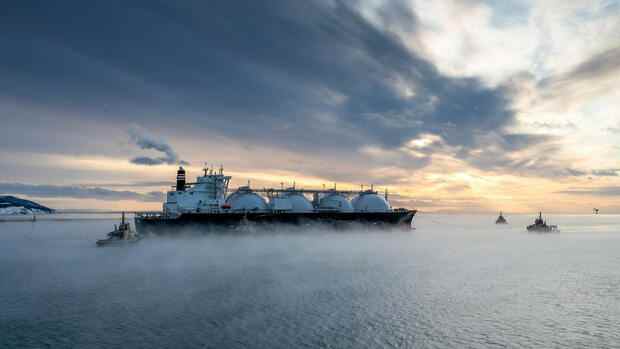Berlin In view of the ongoing gas supply crisis, the construction of LNG terminals in Germany is becoming the focus of the debate. The developers of such terminals, which can process liquefied natural gas (LNG) from LNG tankers and make it available for domestic use, are now increasingly relying on the import of green gas.
This allows them to increase the acceptance of their projects. Conventional LNG, i.e. LNG produced on the basis of natural gas, has been heavily criticized by climate protection groups.
In addition to conventional LNG, you can “process bio-LNG and synthetic methane right from the start,” said Johann Killinger, Managing Director of Hanseatic Energy Hub GmbH (HEH), the Handelsblatt. The company plans to build an LNG terminal in Stade. Shareholders are the gas infrastructure operator Fluxys (Belgium), the Partners Group (Switzerland) and the Buss Group from Hamburg.
Killinger can point to interested parties who could immediately use the infrastructure to import green gas. “The LNG terminal project in Stade fits in perfectly with our plans. We could start supplying significant amounts of advanced bio-LNG and synthetic LNG in two to three years,” said Claus Sauter, head of Verbio AG, the Handelsblatt.
Top jobs of the day
Find the best jobs now and
be notified by email.
There is talk of “advanced” bio-LNG when production is based on residues, such as straw, and there is therefore no competition for use with food or feed. Synthetic LNG is produced on the basis of green hydrogen.
Verbio wants to supply biomethane from the USA
“I think it’s realistic to deliver six-digit tons from 2025. So we’re talking about relevant orders of magnitude,” said the Verbio boss. Verbio is one of the leading independent bioenergy producers in Europe.
According to Sauter, 500,000 tons of bio-LNG would save 2.3 million tons of CO2 in the transport sector if bio-LNG replaced diesel trucks. For classification: According to the Federal Environment Agency, a speed limit of 130 kilometers per hour would result in savings of 1.9 million tons per year. The total CO2 emissions from the transport sector in Germany amounted to 150 million tons in 2020.
Sauter sees the amount of 500,000 tons of bio-LNG only as an entry that can be “handled easily via Stade”. He assumes that a 40,000-ton ship is handled every month.
“We can produce advanced biomethane in the US much cheaper than in Europe. This results in considerable potential for reducing greenhouse gases in Europe, especially in the transport sector,” said Sauter. In December 2021, the company started up a production facility in the US state of Iowa.
Bio-LNG as an alternative to diesel
Bio-LNG and synthetic LNG are highly attractive for freight forwarders and at the same time a cost-effective alternative to renewable hydrogen for industry, said Sauter. However, the potential can only be used if the appropriate infrastructure is in place.
The second LNG project in Germany, the terminal in Brunsbüttel, also aims to process green gas. A report commissioned by the operating company, German LNG Terminal GmbH, came to the conclusion that the terminal planned in Brunsbüttel could be used “multifunctionally”. In principle, the landing of liquid methane, liquid hydrogen or liquid ammonia is possible, according to the report.
German LNG Terminal GmbH recently announced that one of its three shareholders, the Dutch company Vopak, was changing from an active to a passive shareholder. The managing director sent by Vopak to German LNG Terminal GmbH returned to Vopak. This had fueled doubts about the realization of the project. However, the planning for the project continues.
So far there has been no terminal in Germany through which liquefied gas could be imported by tanker. LNG can therefore not be imported directly. LNG importers are currently using terminals in the Netherlands, Belgium, Great Britain or Poland. There, the liquefied gas is converted back into its gaseous state and fed into the gas network. It can also reach Germany via the European network.
In view of the current gas supply crisis, the import of LNG is gaining in importance. The subject of LNG has become an integral part of energy policy speeches by Federal Economics Minister Robert Habeck (Greens).
Just a few days ago, Habeck said in the Bundestag that if not enough natural gas arrives via pipelines, you have to buy LNG. “LNG requires that there is infrastructure,” he said. However, the two terminals in Brunsbüttel and Stade “so far cannot be financed privately,” said Habeck and announced: “We will now address this question energetically.”
For Habeck, the topic is fraught with risks
Many Greens members and climate protection organizations reject LNG terminals. They argue that their construction will solidify “fossil infrastructure”. In particular, LNG, which is produced on the basis of the controversial fracking method in the USA, is on the index for climate protectors. Organizations such as the German Environmental Aid (DUH) therefore actively combated LNG projects.
Habeck does not seem to be deterred by this. The statements by the Federal Minister of Economics are “promising”, said HEH boss Killinger. “Germany must finally send the binding signal to international producers that LNG terminals are also being built in this country. Political support helps us,” he said. The conditions for using the gas networks would have to be improved.
The conditions are better in neighboring EU countries such as the Netherlands. “In order to improve the framework conditions here, we encourage a dialogue with the Federal Network Agency, the operators and politicians,” said Killinger.
More: Battle for natural gas – How Germany wants to save the supply
